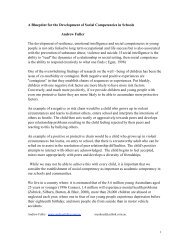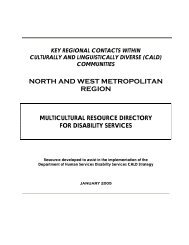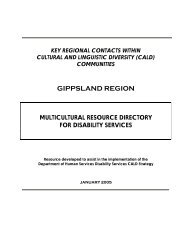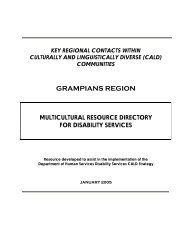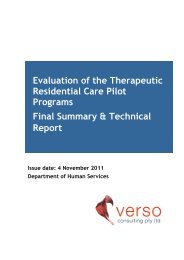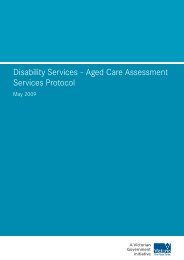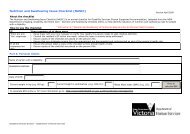Positive Behaviour Support - Department of Human Services - Vic ...
Positive Behaviour Support - Department of Human Services - Vic ...
Positive Behaviour Support - Department of Human Services - Vic ...
Create successful ePaper yourself
Turn your PDF publications into a flip-book with our unique Google optimized e-Paper software.
58 <strong>Positive</strong> behaviour support: Getting it right from the start - Facilitators reference manual<br />
<strong>Behaviour</strong> recording<br />
PowerPoint 80*<br />
Key steps in completing a functional behaviour assessment<br />
Step 1: Defining the behaviour <strong>of</strong> concern<br />
Need to write the behaviour in a way that the actual behaviour <strong>of</strong> concern can be easily<br />
understood by others and that then can be used to gain reliable documentation on when<br />
and when it does not occur.<br />
Step 2: Finding out as much information as possible about the behaviour, which is<br />
information on:<br />
• What happens before the behaviour?<br />
• What happens during the behaviour?<br />
• What happens after the behaviour?<br />
This will require the use <strong>of</strong> recording forms such as STAR Charts or questionnaires like the,<br />
Motivational Assessment Scale. 19<br />
Step 3: From information collated via the recording forms/questionnaires, come up with an<br />
idea (hypothesis) about why the behaviour is occurring, that is what purpose/function does<br />
the behaviour appear to be serving for the person. Some <strong>of</strong> the most common reasons why<br />
behaviours <strong>of</strong> concern occur:<br />
• Gaining social interaction<br />
• Escape or avoidance <strong>of</strong> demands<br />
• Gaining access to referred activities or tangible objects<br />
• Sensory feedback (hand flapping, eye poking)<br />
• Pursuit <strong>of</strong> power and control over own life<br />
• Reduction <strong>of</strong> arousal and anxiety.<br />
Step 4: Test your idea (hypothesis) by systematically introducing strategies such as<br />
environmental changes, skill development strategies and planned responses to behaviours.<br />
These strategies must be linked to why the person is using the behaviour. The introduction and<br />
consistent implementation <strong>of</strong> these strategies should result in a reduction to the frequency and<br />
intensity <strong>of</strong> the target behaviour and over time, an increase in the person’s quality <strong>of</strong> life.<br />
Step 5: Regularly monitor, evaluate and review the effectiveness <strong>of</strong> the strategies: Thinking about<br />
what worked and what needs to change. Ongoing data collection will be required to monitor or<br />
check that your ideas about the behaviour are correct.<br />
19. Motivation Assessment Scale Durand and Crimmins 1992



